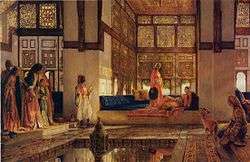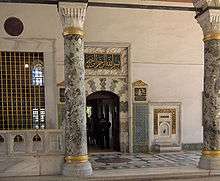Seraglio




A seraglio (/səˈræljoʊ/ sə-RAL-yoh or /səˈrɑːljoʊ/ sə-RAHL-yoh) or serail is the sequestered living quarters used by wives and concubines in an Ottoman household. The term harem is a generic term for domestic spaces reserved for women in a Muslim family, which can also refer to the women themselves.
Etymology
The etymology of this Italian word is unclear. The Italian Treccani dictionary gives two derivations:[1] one from Turkish saray,[2][3] from Persian saraʾi (سرای),[4] meaning palace, or the enclosed courts for the wives and concubines of the harem of a house or palace, the other (in the sense of enclosure for wild animals) from Late Latin: serraculum, derived from serare, to close, which comes from sera,[5] a door-bar.[6]
In Ottoman culture
In the context of the turquerie fashion, the seraglio became the subject of works of art, the most famous perhaps being Mozart's Singspiel, Die Entführung aus dem Serail (The Abduction from the Seraglio). In Montesquieu's Persian Letters, one of the main characters, a Persian from the city of Isfahan, is described as an occupant of a seraglio.
"The Seraglio" may refer specifically to the Topkapı Palace, the residence of the former Ottoman Sultans in Istanbul. The term can also refer to other traditional Turkish palaces—every imperial prince had his own—and other grand houses built around courtyards.
In Italy
In modern Italian the word is spelled serraglio. It may refer to a wall or structure for containment, for example of caged wild animals; or for defence, such as the Serraglio of Villafranca di Verona, a defensive wall built by the Scaligeri.[7] The ghettoes established in many Italian cities following the promulgation by Pope Paul IV in 1555 of the papal bull Cum nimis absurdum were initially called serraglio degli ebrei, "enclosure of the Jews".[8]
The Seraglio is also an artificial island on which Mantua is located.
See also
- Caravanserai, another word involving saray, is an inn or rest stop for caravans
- Sarayburnu (also known as Seraglio Point)
- Grand Serail in Beirut, Lebanon, now the office of the prime minister of Lebanon
- Imperial Harem
- Harem
- The Abduction from the Seraglio, opera singspiel by Mozart.
- Zenana
References
- ↑ "Serraglio", in Treccani: Vocabolario on line. Rome: Istituto della Enciclopedia Italiana. (in Italian) Accessed May 2013.
- ↑ Sarah Fielding. "Dictionary.com". Dictionary.reference.com. Retrieved 2014-08-11.
- ↑ "TheFreeDictionary". TheFreeDictionary. Retrieved 2014-08-11.
- ↑ Harper, Douglas. "seraglio". Online Etymology Dictionary.
- ↑ "sĕra", entry from Lewis & Short. Latin Word Study Tool, Perseus. Accessed May 2013.
- ↑ Macdonald, A.M. (ed.) (1972) Chambers Twentieth Century Dictionary London: Chambers ISBN 055010206X
- ↑ "Serraglio1", in Treccani: Vocabolario on line. Rome: Istituto della Enciclopedia Italiana. (in Italian) Accessed May 2013.
- ↑ Debenedetti-Stow, Sandra (1992). "The Etymology of "Ghetto": New Evidence from Rome". Jewish History 6 (1/2), The Frank Talmage Memorial Volume: 79-85 (subscription required)
External links
| Look up seraglio in Wiktionary, the free dictionary. |
| Wikimedia Commons has media related to Seraglio. |